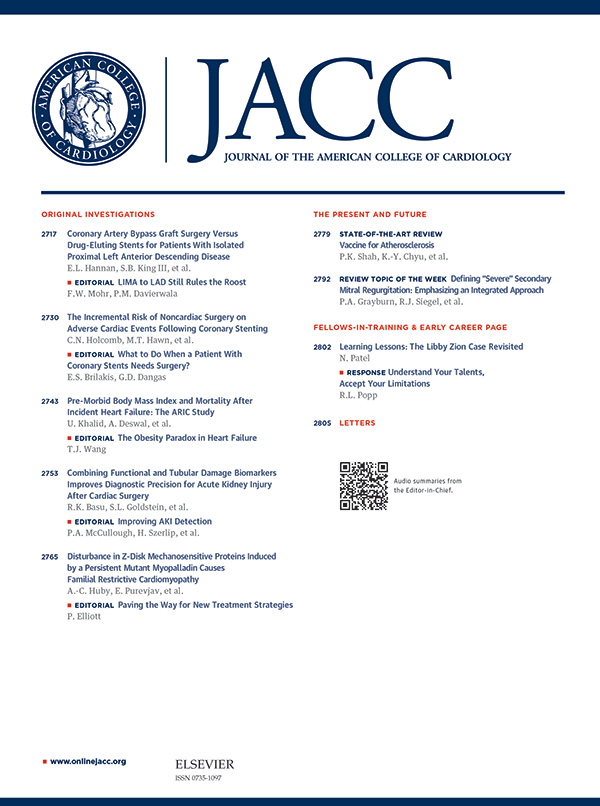Proactive Mapping and Preventive Ablation Reduce Defibrillator Implantation Rates in Tetralogy of Fallot
IF 21.7
1区 医学
Q1 CARDIAC & CARDIOVASCULAR SYSTEMS
引用次数: 0
Abstract
Background
In patients with repaired tetralogy of Fallot (rTOF) and spontaneous ventricular tachycardia (VT), transection of slow-conducting anatomical isthmus (SCAI) by ablation results in excellent long-term VT-free survival. In patients without prior VT, proactive electroanatomical mapping and preventive SCAI ablation may impact patient selection for primary prevention implantable cardioverter-defibrillator (ICD) implantation.
Objectives
The purpose of this study was to evaluate long-term outcomes after proactive electroanatomical mapping and ablation of SCAI and its impact on patient selection for primary prevention ICD implantation, compared with current risk stratification methods in rTOF patients without prior VT.
Methods
Consecutive rTOF patients without prior VT who underwent electroanatomical mapping for VT substrate identification were included (2005-2020). After successful SCAI ablation, ICD implantation was offered but was subject to shared decision making. The potential eligibility for ICD implantation was retrospectively determined using the following: 1) a clinical risk score; 2) guideline-recommended risk factors (American Heart Association [AHA] 2018 guidelines without late gadolinium enhancement [LGE] on cardiac magnetic resonance [CMR] information, AHA 2018 guidelines with LGE-CMR information, European Society of Cardiology [ESC] 2022 guidelines); and 3) electroanatomical mapping and SCAI ablation results. In the latter, patients with a nontransected SCAI, VT substrates remote from anatomical isthmuses, or severe right-/left ventricular dysfunction qualified for ICDs.
Results
A total of 97 patients were included (age 35 ± 16 years, 57 men); 33 patients (34%) had SCAI and 19 (20%) had inducible monomorphic VT (17 of 19 SCAI-dependent VT). Successful SCAI transection was achieved in 87% (26 of 30 patients) in whom attempted, without complications. In total, 13 patients received an ICD implantation. During a median follow-up of 58 months (Q1-Q3: 30-99 months), 4 patients (4%) had VT, all after ablation failure. According to clinical risk score, AHA 2018 guidelines without LGE-CMR information, AHA 2018 guidelines with LGE-CMR information, and ESC 2022 guidelines, 49 (51%), 24 (25%), 31 (32%), and 48 patients (49%) would have qualified for ICDs, respectively. After proactive mapping and preventive ablation, 11 patients (11%) remained ICD candidates, including all 4 with a VT event during the follow-up (annual VT risk 7%/y).
Conclusions
Long-term outcome of rTOF patients without SCAI is excellent. Proactive electroanatomical mapping and preventive SCAI ablation may significantly reduce primary prevention ICD implantation rates compared with current risk prediction methods.
主动定位和预防性消融降低法洛四联症患者除颤器植入率
在修复法洛四联症(rTOF)和自发性室性心动过速(VT)的患者中,通过消融切断慢传导解剖性峡部(SCAI)可获得良好的长期无室性心动过速生存。对于先前没有室性心动过速的患者,主动电解剖定位和预防性SCAI消融可能会影响患者选择一级预防植入式心律转复除颤器(ICD)植入术。本研究的目的是评估主动电解剖定位和消融SCAI后的长期结果及其对患者选择一级预防ICD植入的影响,并与目前无VT病史的rTOF患者的风险分层方法进行比较。方法纳入了无VT病史的连续rTOF患者,他们接受了电解剖定位以确定VT底物(2005-2020)。SCAI消融成功后,提供ICD植入,但需要共同决策。采用以下方法回顾性确定ICD植入的潜在资格:1)临床风险评分;2)指南推荐的危险因素(美国心脏协会[AHA] 2018年无晚期钆增强[LGE]心脏磁共振[CMR]信息指南,AHA 2018年含LGE-CMR信息指南,欧洲心脏病学会[ESC] 2022指南);3)电解剖定位和SCAI消融结果。在后者中,未横断的SCAI、VT底物远离解剖峡部或严重的右/左心室功能障碍的患者符合icd的条件。结果共纳入97例患者(年龄35±16岁,男性57例);33例(34%)有SCAI, 19例(20%)有诱导性单型室速(19例SCAI依赖性室速中有17例)。87%(30例患者中的26例)的SCAI横断成功,无并发症。总共有13例患者接受了ICD植入。在中位随访58个月(Q1-Q3: 30-99个月)期间,4例(4%)患者发生房颤,均为消融失败后。根据临床风险评分,不包含LGE-CMR信息的AHA 2018指南、包含LGE-CMR信息的AHA 2018指南和ESC 2022指南分别有49例(51%)、24例(25%)、31例(32%)和48例(49%)患者符合icd的要求。在主动定位和预防性消融后,11例(11%)患者仍然是ICD候选者,包括所有4例在随访期间发生VT事件(年VT风险7%/年)。结论无SCAI的rTOF患者长期预后良好。与目前的风险预测方法相比,主动电解剖定位和预防性SCAI消融可显著降低一级预防ICD植入率。
本文章由计算机程序翻译,如有差异,请以英文原文为准。
求助全文
约1分钟内获得全文
求助全文
来源期刊
CiteScore
42.70
自引率
3.30%
发文量
5097
审稿时长
2-4 weeks
期刊介绍:
The Journal of the American College of Cardiology (JACC) publishes peer-reviewed articles highlighting all aspects of cardiovascular disease, including original clinical studies, experimental investigations with clear clinical relevance, state-of-the-art papers and viewpoints.
Content Profile:
-Original Investigations
-JACC State-of-the-Art Reviews
-JACC Review Topics of the Week
-Guidelines & Clinical Documents
-JACC Guideline Comparisons
-JACC Scientific Expert Panels
-Cardiovascular Medicine & Society
-Editorial Comments (accompanying every Original Investigation)
-Research Letters
-Fellows-in-Training/Early Career Professional Pages
-Editor’s Pages from the Editor-in-Chief or other invited thought leaders

 求助内容:
求助内容: 应助结果提醒方式:
应助结果提醒方式:


